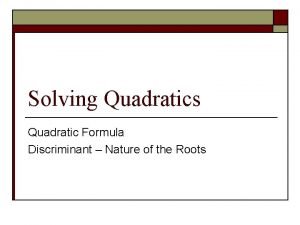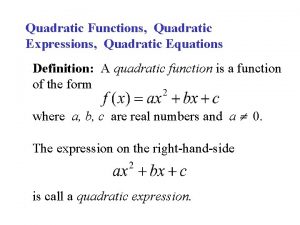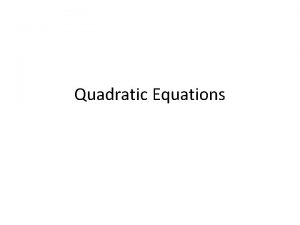Quadratic Formula Class X SANJAY KUMAR SINHA TGTMATHS












- Slides: 12

Quadratic Formula Class X SANJAY KUMAR SINHA TGT-MATHS KV JEHANABAD

4. 3 Quadratic Formula The roots of a quadratic equation are… • the solutions for the variable. • related to the zeros of the corresponding function. • related to the x-intercepts of the graph of the corresponding function. No real number x-intercepts One real x-intercept No real number zeros One real zeros No real number roots Two equal real roots …solutions One real solution Two real x-intercepts Two real zeros Two distinct real roots Two real solutions

The Quadratic Formula The roots of the quadratic equation ax 2 + bx + c = 0 can be found by using the quadratic formula:

Deriving The Quadratic Formula Determine the solutions by completing the square.

Two Equal Real Roots Solve x 2 + 3 x - 2 = 0. x =– b + b 2 – 4 ac 2 a x = – 3 + 32 – 4(1)(– 2) 2(1) Quadratic formula a = 1, b = 3, c = – 2 x = – 3 + 17 2 The solutions are x = – 3 + 17 2 x = – 3 – 17 – 3. 56. 2 CHECK Simplify. PEMDAS Two distinct real roots 0. 56 or Graph y = x 2 + 3 x – 2 and note that the x-intercepts are approx. 0. 56 and – 3. 56. 4. 3. 4

Solving Quadratic Equations Using the Quadratic Formu Solve 2 x 2 - 5 x + 2 = 0. a = 2, b = -5, c = 2 Two distinct real roots 4. 3. 5

Solving Quadratic Equations that have No Real Roots Solve x 2 - 5 x + 7 = 0. No real roots 4. 3. 6

Solving Quadratic Equations with Two Equal Real Root Solve x 2 - 6 x + 9 = 0. Two Equal real roots 4. 3. 7

Determining The Nature of the Roots The quadratic formula will give the roots of the quadratic equation. From the quadratic formula, the radicand, b 2 - 4 ac, will determine the Nature of the Roots. By the nature of the roots, we mean: • whether the equation has real roots or imaginary • if there are real roots, whether they are different or equal The radicand b 2 - 4 ac is called the discriminant of the equation ax 2 + bx + c = 0 because it discriminat among the three cases that can occur. 4. 3. 8

The discriminant describes the Nature of the Roots of a Quadratic Equation If b 2 - 4 ac > 0, then there are two different real roots. If b 2 - 4 ac = 0, then there are two equal real roots. If b 2 - 4 ac < 0, then there are no real roots. 4. 3. 9

Use the discriminant to determine the nature of the roots. Equation ax 2 + bx + c = 0 Discriminant b 2 – 4 ac a. 2 x 2 + 6 x + 5 = 0 62 – 4(2)(5) = – 4 b. x 2 – 7 = 0 c. 4 x 2 – 12 x + 9 = 0 (– 12)2 – 4(4)(9) = 0 02 – 4(1)(– 7) = 28 Nature of Roots No real roots Two distinct real roots Two equal real roots 4. 3. 10

Determine the value of k for which the equation x 2 + kx + 4 = 0 has a) equal roots b) two distinct real roots c) no real roots a) For equal roots, b 2 - 4 ac = 0. Therefore, k 2 - 4(1)(4) = 0 The equation has equal roots k 2 - 16 = 0 when k = 4 and k = -4. k 2 = 16 k=+4 b) For two different real roots, b 2 - 4 ac > 0. k 2 - 16 > 0 k 2 > 16 Therefore, k > 4 or k < -4. This may be written as | k | c) For no real roots, b 2 - 4 ac < 0 k 2 < 16 Therefore, -4 < k < 4. This may be written as | k 4. 3. 11 |<4























